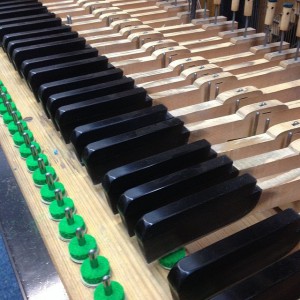The history of the pianoforte
 Perhaps no single instrument has had more of an effect on the history of music than the pianoforte, or piano, as it has become known.
Perhaps no single instrument has had more of an effect on the history of music than the pianoforte, or piano, as it has become known.
Pianoforte is a combination of the Italian words for ‘soft’ and ‘loud’, and this gives us a clue as to the instrument’s origins. It was one of the first to be able to offer different timbres depending on the style of play, making it a uniquely expressive instrument.
Padua, Italy, 1709
A harpsichord maker named Bartolomeo di Francsesco Cristofori created the piano in the early 18th century. It evolved from other keyboard instruments, such as the clavichord and the harpsichord, so it built on a design that was already centuries old.
Clavichords and harpsichords worked by mechanical means; a hammer was released when a key on the keyboard itself was pressed. There was no way to vary the volume of the note, which made them less versatile than other orchestral instruments.
The piano Cristofori created was capable of varying the volume of the notes that were produced in response to how hard the keys were hit. He named it ‘Gravicembalo Col Piano e Forte’, which roughly translates as ‘soft and loud keyboard instrument’, and connects the dots nicely to our modern name for the instrument.
Not an instant hit
Despite the influence the piano has had on music, the instrument did not gain instant favour with musicians, composers and the public. Bach, for example, did not like pianos at all in his early years, but he did eventually come round to the instrument.
It wasn’t until Johann Andreas Stein made several improvements to Cristofori’s design in 1772 that the piano’s popularity began to rise.
Mozart was the musician and composer who really helped cement the piano’s appeal, as he became a virtuoso on the instrument and wrote several piano concertos. Beethoven also became a huge influence on the piano’s popularity, writing Moonlight Sonata, Pathétique and Für Elise to show off the versatility of the instrument.
And all that jazz
Over the next two hundred years, the piano became easily become the most popular musical instrument for someone to play or learn. In modern times, it has been overtaken by the guitar, but that is no small feat. After Austrian Johann Schmidt created the upright in around 1780, an automated version was produced in the 1880s, where rotating reels of hole-punched paper triggered the notes to be played.
The next huge jump in the piano’s popularity occurred in the early 1900s when the piano became a popular instrument for jazz enthusiasts. Musicians such as Art Tatum and Thelonious Monk produced some amazing pieces of work and completely repurposed the instrument.
The modern piano
Most modern music relies on guitars and percussion, or computers, digital sounds and samples. If a band features a pianist, they are more likely to be referred to as a keyboardist.
Despite this, the piano remains a brilliant and entertaining instrument to learn how to play, especially if you want to obtain an understanding of how music is put together. It remains a popular instrument for children to learn, since it gives a great foundation in reading music and learning the dynamics of a piece.

